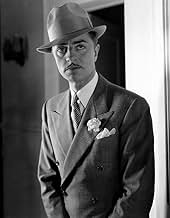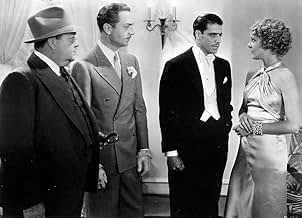Ajouter une intrigue dans votre languePhilo Vance, accompanied by his prize-losing Scottish terrier, investigates the locked-room murder of a prominent and much-hated collector whose broken Chinese vase provides an important clu... Tout lirePhilo Vance, accompanied by his prize-losing Scottish terrier, investigates the locked-room murder of a prominent and much-hated collector whose broken Chinese vase provides an important clue.Philo Vance, accompanied by his prize-losing Scottish terrier, investigates the locked-room murder of a prominent and much-hated collector whose broken Chinese vase provides an important clue.
- Réalisation
- Scénario
- Casting principal
- Sir Thomas MacDonald
- (as Paul Cavanaugh)
- Eduardo Grassi
- (as Jack LaRue)
- Sandy
- (non crédité)
- Terrier at Dog Show
- (non crédité)
- Sgt. Mellish - Desk Sergeant
- (non crédité)
- Police Photographer
- (non crédité)
- Policeman Who Lets Philo's Dog Out
- (non crédité)
Avis à la une
As far as murder mystery films go, it just doesn't get any better than this one. Populated with suspicious characters, all connected to a dog show and all having very good reason to murder the apparent suicide victim Archer Coe, it's truly tough to figure this one out or wrap one's head around it but boy, does it proves fascinating to watch unfold before us. Even the cops, the coroner and the district attorney prove colorful, fleshed out characters adding a level of unexpected gritty realism to this one's proceedings and amping up its overall "fun" factor. I particularly enjoyed the comic scenes involving the coroner (played by Etienne Girardot), who is always it seems to him being rudely and untimely interrupted by the discovery of corpses or injured men during this one's running time. Also Eugene Palette's Detective Sgt. Heath provides welcome, often later delightfully humorous at his expense, critical commentary during Vance's investigation. I cannot think of any valid criticism to give this movie in fact except perhaps that it hasn't dated particularly well. Doesn't stop the movie from being just plain good fun viewing though. Watch and see if you can wrap your head around this one's mystery. Highly recommended you try!
When rich, obnoxious Archer Coe is murdered, the case causes lots of difficulty for the police. It's bad enough that Coe's meanness gave a good reason for murder to pretty much anyone who ever knew him, but it's even worse that the clues are so complicated that he could have been killed in at least two completely different ways. Only Vance can figure it all out, and after some good twists, there is an interesting and creative solution.
Though basically filmed as a routine whodunit, there are several good features besides the story itself. Powell is as lively as Vance as he was later as Nick Charles in the "Thin Man" films. Most of the rest of the cast is good, too, especially Mary Astor as one of the suspects and Eugene Pallette as the earnest but not very bright sergeant in charge of the case. Everything moves along quickly with many good touches of humor.
Most mystery fans will find this movie entertaining and enjoyable.
Though Kennel is one of the better Philo Vance novels, this adaptation of the eponymous book represents the rare case where a film is better than the original story (which would not film well if precisely represented on screen because of (1) the psychological issues which would be hard to depict, and (2) the novel's culminating violent scene, which the film modifies).
The genius in taking one of the lesser of the canonical Philo Vance novels and making it into a classic is, of course, Michael Curtiz's direction; Curtiz being an exceptionally talented director who has, perhaps, the misfortune of being eclipsed by the fame of his films (e.g., Casablanca, Mildred Pierce, and The Adventures of Robin Hood) because of lack of a distinctive style.
This film is also a successful example of an early talkie: the sound is fairly good except in some scenes where the boom is obviously too far away, and in one shot (between Robert Barrat and Helen Vinson) we actually see the microphone! Some of the actors are clearly still making the silent-to-sound transition, but the performances are uniformly good. The key scene stealer is Etienne Giradot, who plays the Coroner, Dr. Doremus. Indeed, his performance is so endearing he reprised the role in other Philo Vance films.
While it becomes fairly easy to guess the culprit, the film doesn't suffer for this because of the excellent direction, good sets and wardrobe (check out Mary Astor's chic outfits!), and fine performances. (Though primarily loved for his work as Nick Charles in the Thin Man films, William Powell gives one of the best (and most subtle) performances of his career in Kennel.) Besides its status as a Hollywood classic, Kennel is an outstanding example of successful story adaptation and early sound film-making. (One can also see some noir hints later fulfilled in Curtiz's Mildred Pierce.) Highly recommended.
Le saviez-vous
- AnecdotesAlthough they share no scenes, William Powell and Asta appear in this picture, more than a year before L'introuvable (1934) series began.
- GaffesWhen Philo Vance opens the closet door, a dead Brisbane Coe falls out, and his hat rolls away from his head. But on the closeup shot of the dead body immediately after, the hat is back on Brisbane's head. Then on the next shot, which is of Brisbane and the servant, the hat is once again off his head.
- Citations
Philo Vance: What do you think of the suicide theory now, Sergeant?
Detective Sgt. Heath: Well, it's slightly complicated since the man shot, slugged and stabbed himself - especially in the back.
- ConnexionsFeatured in The World's Best Known Dicks (1987)
Meilleurs choix
Détails
- Date de sortie
- Pays d’origine
- Langue
- Aussi connu sous le nom de
- Le mystère de la chambre close
- Lieux de tournage
- Société de production
- Voir plus de crédits d'entreprise sur IMDbPro
Box-office
- Montant brut aux États-Unis et au Canada
- 961 380 $US
- Montant brut mondial
- 1 486 760 $US
- Durée
- 1h 13min(73 min)
- Couleur
- Mixage
- Rapport de forme
- 1.37 : 1



































